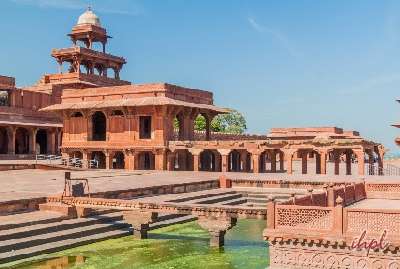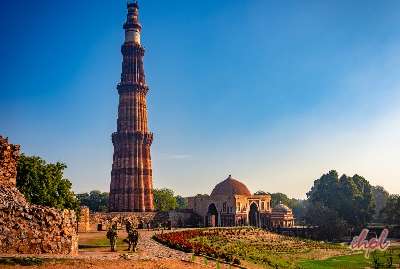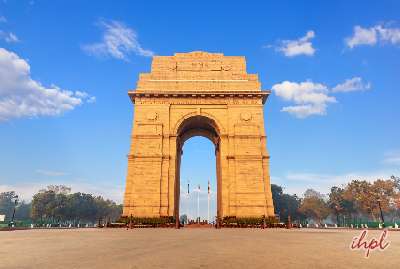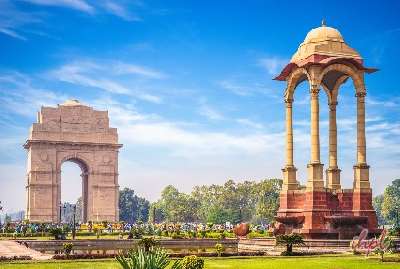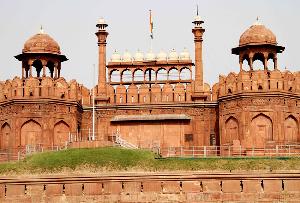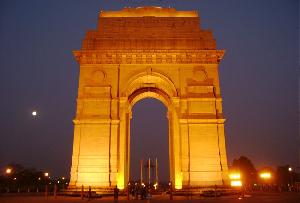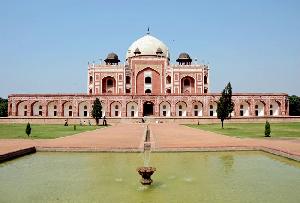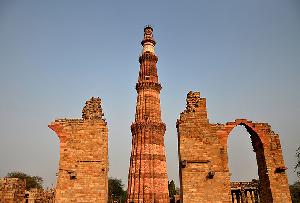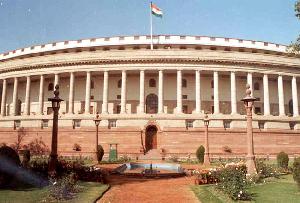Located in the grounds of Guru Gobind Singh Indraprastha University in Delhi, the famous Dara Shikoh Library now functions as the office of the Archaeological Department of Delhi Government. Built by Dara Shikoh, Mughlal emperor Shahjahan’s son and chosen successor, this building boasts of immense historical importance. The death of Dara in 1659 also meant the destruction of his library as it was given to the subedar of Lahore, Ali Mardan Khan. The building further changed hands before finally being captured by the British in 1803. The subsequent owners have modified the building a number of times till recently when it came under Delhi Government.
This perhaps explains why nothing typically Mughal in style or architecture is visible here. The entire complex is surrounded by jamun trees, huge white pillars, representing British architecture, and wooden blinds covering the verandahs. The only remnant of the splendor of Mughal architecture could be seen in the basement with its red sand-stone arches and ornamental pillars.
An Archaeological Museum has been set up in Dara Shikoh Library Building and it comprises of two galleries. Relics excavated from three Sites in Delhi ranging from the late Harappan times to the Medieval Period are on display in one gallery and the other one displays sculptures in the custody of the Archaeological department.
History:
The Dara Shikoh Library in Delhi is an important library located near the General Post Office in Delhi, India. The building is historically very important because it was built by Dara Shikoh, the eldest son of Mughal emperor Shahjahan, and was later used as the residence of Sir David Ochterlony – the first British resident of Delhi. After Aurangzeb murdered Dara Shikoh in 1659, the ownership of this library passed through many hands until it finally landed with the British who took it from the Marathas in 1803.
Sir Ochterlony revamped the original structure of the building by adding few pillars and a verandah. The room which now serves as the library was one of those used by Dara Shikoh. The interior of the building still reflects the architectural splendor of the Mughals while the exterior boasts of the typical British style. It was greatly damaged
Located in the grounds of Guru Gobind Singh Indraprastha University, Delhi, near the General Post Office, is the Dara Shikoh Library of the Department of Archaeology, Delhi Administration. The building is of immense historical importance as it was built by Shah Jahan’s liberal intellectual son and chosen successor, Dara Shikoh, and was later used as a residency by Sir David Ochterlony, the first British Resident of Delhi. Dara Shikoh was murdered by his brother Aurangzeb in 1659 and his property along with this library passed through several hands before the British finally took it from Marathas in 1803.
Sir Ochterlony renovated the original building of Dara Shikoh and added the pillars and the verandah to the older structure. The present library was one of the rooms used by Dara Shikoh. If one looks carefully one can differentiate between the architectural designs of the interior (Mughal) and exterior (British) of the building. This task can be a bit time consuming because the building was damaged to a great extent during the 1857 war and robbed of its precious books. However, one can still imagine the grandeur and opulence in which the first British Resident lived in Delhi, by looking the majestic building. The building also characterized the nature of its first occupant, Sir Ochterlony. He was one of the only British officers who fully adopted the Mughal culture, customs, traditions and lifestyle. Dara Shikoh Library Building is popularly known by its name due to its association with Dara Shikoh, eldest son of Shahjahan, the Mughal emperor. It was once the residence of Ali Mardan Khan, Mughal Viceroy of Punjab(1639 A.D.), later enlarged by the British and used as residency of Sir David Octherlony during 1803 AD. It had also housed a Govt. College and school from 1804 to 1904 A.D. During this period, the building had undergone considerable changes. There is a basement on the rear side of the building which was hidden by debris and stair case. After removing the debris and stairs, the original Mughal structure was exposed in the year 2001 thereby discovered red sand stone arches and ornamental pillars.
Dara Shikoh (1615–1659) was the eldest son of the Mughal Emperor Shah Jahan and his wife Mumtaz Mahal.
Fast – Facts:
Location:
½ Kilometer from Kashmiri Gate on Lothian Road, next to Kashmiri Gate General Post Office, Old Delhi.
Time to visit: Open on all days
Preferred Timings: 10.00 am-5.00 pm
Admission Fees: Free and open to all
Photography charges: Prior permission required, check with the local authorities
How to Reach:
Tourists can either take local buses from various points within the city to reach this monument, which is located near Kashmiri Gate, Inter State Bus Terminal in Old Delhi or they can hire auto-rickshaws and taxis or metro rail.
Nearest Railway Station: Old Delhi Railway Station
Nearest Metro Station: Kashmiri Gate
Functional Metro Station: Kashmiri Gate
Nearest International Airport: Indira Gandhi International Airport
Time required for sightseeing: 30 minutes
Nearby Attractions:
The Dara Shikoh Library is one of the important historical places of interest in Delhi. Its convenient location next to the Kasmeri Gate G.P.O., also helps in making it a must visit destination in Delhi. There are a lot of Tourist Places nearby which include:
British Magazine
Located at the heart of Lothian Road, just in front of the Post office, there are two similar structures commonly known as British Magazine. These are the ruins of an extensively fortified historical building, which once used to store the ammunition of the British troops.
St. James Church
St. James Church is a historical church that was built in 1836 by the famous Colonel James Skinner. Located very close to the Kashmeri Gate, St. James Church is said to be the oldest in the Capital. Though the church was built in the classical renaissance style, yet it does not follow the strict classical rules.
Lothian Cemetary
Lothian cemetery – the first British cemetery of Delhi, is located on Lothian Road near Kashmeri Gate on the northeast side of the Lothian railway bridge. With gravestones dating back to 1808 scattered behind a grey tower near the bridge, the Lothian cemetery’s unique feature is an imposing Celtic cross dedicated to the Europeans killed in Delhi during the 1857 War.
Jama Masjid
Originally known as Masjid-i-Jahanuma, Jama Masjid – built by emperor Shahjahan in 1656 – is the most famous mosque in India. The mosque was built in typical Mughal style with two minarets and three domes and lies to the west of the Hussainabad Imambara.
Chandni Chowk
One of the main markets of Delhi, Chandni Chowk is located opposite the Red Fort. The area was once lined with beautiful fountains. But in recent times the place has become very crowded and congested.
Salimgarh Fort
The historic Fort of Salimgarh located adjacent to the Red Fort across the Ring Road. Built by Sher Shah Suri’s son Salim Shah, Salimgarh Fort was used by the British as a prison for the freedom fighters. After Indepnedence, the fort was renamed as Swatantrata Senani Smarak.
Fatehpuri Masjid
The Fatehpuri masjid is a red sandstone mosque that is located on the western end of Chandini Chowk. It was built by Mughal emperor Shah Jahan’s wife Fatehpuri Begum in 1650.
Kashmeri Gate
Located near the Inter State Bus Terminal, Kashmeri Gate was one of the important gates of Shahjahanabad as the royal processions used to pass through the gate on their trips to Kashmir or northern India. The British later fortified Kashmeri Gate in 1835 and made it a double gateway.
Rajghat
Located 4km away from Janpath, on the west bank of Jamuna River, Rajghat is the place where Mahatma Gandhi was cremated. Set amidst deep green lawns, the memorial is a simple open platform inscribed with the Mahatma’s last words, ‘Hey Ram’ (Oh God).



